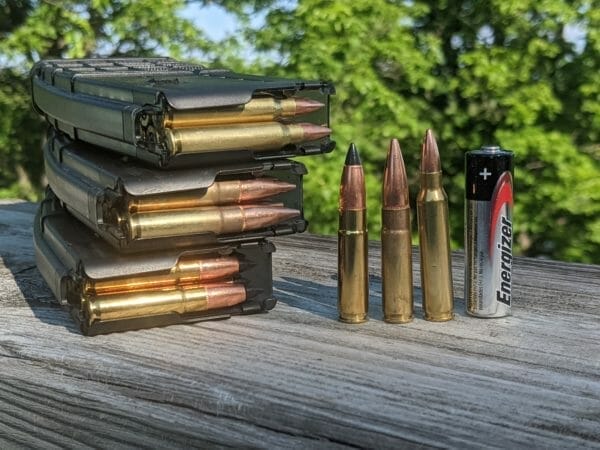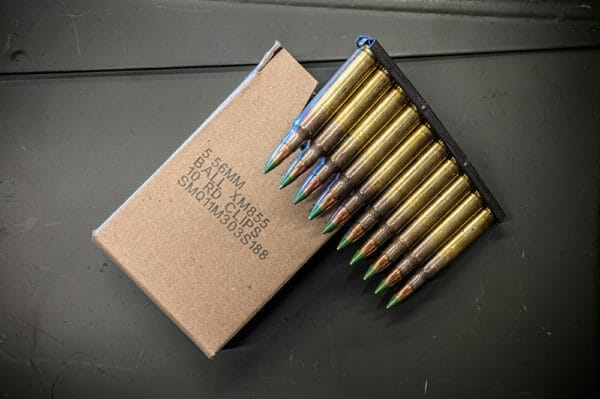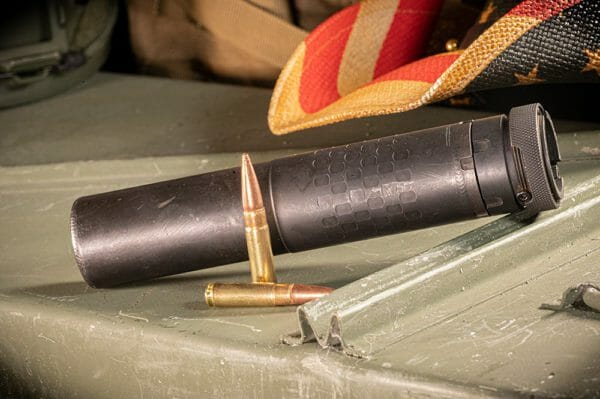
U.S.A. –-(AmmoLand.com)- 300 v 556? It almost sounds like a court case. DC v Heller, Roe v Wade, etc. The truth is, many shooters look at this as if it really is some kind of court case. The problem with that thought is simple. The jury is still out for many of us.
There are people who are fueling their flamethrowers as you read this. The title alone will get their ire chain on the big sprocket and they’re reading to burn anyone on the other side of this discussion to the ground. I have to admit, I have deeply held opinions myself. But when it comes to the firearms industry, there don’t seem to be as many absolutes as you’d think other than safety measures. There used to be plenty of black and white, but through industry innovation, continual sidestepping of law, codification, or ignorant rule, and the desire for niche performance, we have plenty of grey areas today.
When I was pitched the idea of writing about the 300 Blackout in comparison to the 5.56NATO, I assumed it would be a walk in the park. I’ve built countless weapons for customers, my corporate collection, and my personal collection in both. I’ve used both of these chamberings for everything from target shooting, training, and practice, to home defense, hunting, and carry. Why would writing a series of articles be a problem? Well, as I found out, making a choice of one over the other isn’t as simple as you’d think.
We should start at the beginning, or a brief history, of both in order to grasp their originally intended uses. After all, I learned long ago in church that the most vital thing to seek in scripture is context. If you don’t have the context of the subject matter, you’re in real trouble.
5.56 NATO/.223 Ammunition

There was a concept floating around in the 1950s that a small speedy bullet might be superior to a large slow one in terms of performance and also easier to use in fully automatic firing situations. I’m not weighing in on which is better or worse. I’m just offering the context. You also need to consider that 1950 was a long time ago. Both projectiles and powder have come a long way since then. An opportunity arose to offer some new infantry weapons and along with a new platform came new rounds. With irony, Stoner offered the AR-10 in 7.62x51NATO, which wasn’t ultimately accepted. However, a parting gift was offered. The AR-10 had a great impact and a scaled-down version loomed larger in the mirror. This wasn’t as simple as laying it on the copy machine at work and hitting the, “Reduce by 20%,” button, but you get the idea.
The original testing design which used the .222 Remington was fine for testing, but the Stoner team agreed that the particular brass case wasn’t as tough as they’d like for the pressures they eventually wanted to utilize. This gave way to the .222 Special and was later renamed the .223 Remington. It was a tad beefier and a bit longer, so it could handle the pressure and feed pretty well due to length. There were highs and lows with the .223 Remington, which we grasp as the civilian version of the 5.56. But testing ultimately was favorable over a period of years.
Vietnam and Southeast Asian conflict had shown to be a significant spread of Communism, and opportunities presented themselves to field test the AR-15 rifle system. Politics, roadblocks of all kinds, and practical concerns were raised. The chief among them was, “Why change weapon systems and chamberings when we have a bajillion M2s and all the ammo we could need for them already bought and paid for?” I don’t actually know if anyone said, “bajillion,” and I’m not certain “bajillion” is even a word. But, it represents a lot. And I believe it was a natural question to have asked and answered. General LeMay was like a dog with a bone and had a track record for getting what he wanted – and General LeMay wanted the AR-15, thus the 5.56. NATO eventually picked it up in the late ’70s and gave the 5.56 approval in 1980. Officially, the 5.56×45 NATO, was adopted across many countries and many military branches.
The concept of a smaller and faster projectile coupled with a more controllable response when firing automatic-only took 30 years to be given the nod by the powers that be across the globe. With lighter ammunition and various magazine configurations, the weapon system proved to be a true force multiplier as well. If you were humping an M14 with 13 20-round mags at 21.5lbs, you could now carry an AR15 with 20 30-round mags at 21.6lbs – 280rds @ less than 22lbs became 600rds. Engagement during WWII that was claimed to be 300yds and closer only could be extended with greater success.
There have been many considerations and configurations through the last 70 years. I’ve built weapons in the chambering that were set up with ultra-slow twist barrels so I could send a customer out into a field of prairie dogs using 40gr hollow points. I’ve built ultra-fast twist barreled uppers for target shooting that used 80gr projectiles. The vast majority of rifle configurations fall in between and can swallow everything from 55gr to mid-70s and not a hiccup. The rifle system, when properly understood, is truly versatile, simple, and very sound.
300 Blackout

If it weren’t for such a versatile rifle, in and of itself, it would be hard to imagine the 300BO (300 Blackout). We really must pay respect to the Stoner team, for there was a great idea realized that dramatically changed the world. The sheer versatility the AR series offers us makes a lot of dreams possible. I love that.
I’d heard of the 300 Whisper, and some years later I’d learn who J.D. Jones was. But I didn’t realize until more recently the 300 Whisper was essentially the starting point for the AAC (Advanced Armament Corp) designed 300 AAC BLK. That might sound kind of silly to you, but as you delve deeper into just how many chamberings there are out there in past and present alone, you begin to get the idea. Go find a picture of the 8×35 Ribeyrolle. Soak it up. Then realize that it was developed for carbines over 100 years ago. That’s WWI technology folks. And most would take a quick peek at that and assume it was a 300BO.
To give you an idea of the timing present here, the 300 Whisper, which was never popular, was an early 90’s idea. Fast forward a few years and there was a military call for something akin to the venerable AK-47 round, 7.62×39, for some limited applications. Essentially the ask was this: give us something with better performance in terms of energy, without being too long or heavy, oh, and by the way, a subsonic version would be great, as the 9mm is good, but not great. If you think about it, that’s a pretty tall order. The AK-47 using the 7.62×39 was a great option, but unless you’re going to use a platform eerily similar to the Kalashnikov, you might not see success. The steep angle of the 7.62×39 case in its design lends itself to the need for banana-shaped magazines and snag-free breeches and ramps. Yes, we build, as do countless others, 7.62×39 chambered AR15 rifles. But they often require some tweaks to assure users of peak reliability. It wouldn’t be my first choice of options quite frankly.
When you have a suppressor building company with an eye on military sales giving time and energy to a project in league with Remington Defense, it isn’t a stretch to use a wildly popular and healthy system like the AR15, take its ammo, the 556, chop it, swage it, and stuff in a 30cal bullet.
Imagine you’re capable of using the existing weapon system, and all you have to do is change the barrel, pick a great and forgiving place to drill a gas hole with some system tweaks, monkey around with the projectile sizes and powder, and you’ll be a winner. That’s horribly simplistic but somewhat outlines what took place that got us to today’s 300 ACC.
They really did come up with a winner. I remember at the time it first started to take hold in the market, I had a friend, Thomas, who was enamored with it. He was in his basement whacking off 556 empties like they were going out of style. They looked extremely crude. He’d then zip them through resizing dies, a Giraud trimmer he modified, and he was walking in high cotton. I had no idea what he was doing was going to last. But, he was at the range tearing up the course of fire and enjoying every minute of it. I wasn’t able to realize the full 300BO potential, though, until I bought an upper myself and started to play with it.
At the time, suppressors weren’t legal in Iowa. I had a Type 07 FFL with SOT II, and still do, so a safe full of cans wasn’t a problem for me. It was for Thomas. He made some subsonic 300BO and popped over to the shop one day. He didn’t actually ask if he could try on a can but suggested I try it. Of course, after I enjoyed the ultra-quiet shooting with a significantly louder “DING” from the steel than I was used to with my 556 carbines, I told him he should try on the beat-up YHM can I’d been using. He was transformed. I knew right then and there that not only was this a viable option in the market, but when cans were added, this thing had a real purpose in a relatively open band of use. I also knew the moment suppressors were made legal in Iowa, that he’d have a half dozen on order. …Which came to fruition a few years later.
The background and history of these two commercial chamberings are necessary. If you truly think about it, each and every one of the boxes of ammo you’ll see on any shelf began life as a wildcat cartridge. “Many are called, few are chosen,” was a bit of Matthew I was studying just the other day. It tends to be this way with Wildcat cartridges. There are so many different combinations of possibilities out there, that it truly boggles the mind when you think of all the possible outcomes. But, very few make their way into familiar weapons and are marketed to the masses. In our case, not every conception will run through an M4 flawlessly, use the same mags, and offer different potential outcomes. That makes this ammunition pair mutually exclusive in some realm. We’ll delve into the considerations of performance and applications in the next article as the jury continues deliberations.
About Michael Ware:
Michael is a Christian husband and father to two children. He owns and operates Controlled Chaos Arms, a premier custom weapons shop in the Midwest. He serves as Chairman of the board of Directors at the Iowa Firearms Coalition. The pursuit of truth drives him in research and his writing.
Michael enjoys shooting, hunting, and fishing throughout the Midwest and Rockies. An avid outdoorsman and tireless supporter of all Second Amendment virtues, he can be found in his gun shop, in a tree stand with his kids, or on Capitol Hill lobbying in support of Freedom and Liberty at any given time.

